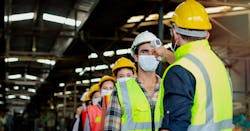The Pandemic Made Manufacturing Stronger
One year into the pandemic, the manufacturing industry has undergone significant disruption and transformation. For a sector that works primarily on-site in physical spaces, the workflow and production changes were abrupt and highly impactful. Leaning on technology, adapting quickly to new demands and supply chain restrictions, and adopting contactless safety processes—all while maintaining productivity and manufacturing essential items to fight COVID-19—were enormous challenges to overcome.
But after one full year of responding and adapting to this crisis, manufacturers have learned a lot about their capabilities. Widespread remote work had never been a serious consideration, but with this shift came some surprising, welcomed insights. Steps to reduce contact and prevent the risks of COVID-19 also improved overall efficiency and workforce safety. The need to pivot to manufacture new products, including PPE, opened the door for new partnerships. Border closures sparked new exploration in global supply-chain innovations. These discoveries have led many to re-evaluate how new processes, ways of working, and adaptability could determine the direction the industry is headed.
As we look toward the future of manufacturing, here are the four lessons learned over the past year that will continue to make the greatest impact on the evolving industry:
1. Adaptability ensures business resilience Few industries were fully prepared for what they were about to face last March. But when the pandemic struck, manufacturers proved that they could rapidly adapt to stay resilient in the face of a crisis. In the previous century, manufacturers answered the call during World War II—prioritizing production of essential items to support the wartime efforts. In 2020, the enemy was COVID-19, and the essential items were personal protective equipment (PPE). The manufacturing industry was vital to the cause.
Shifting from a specific component or part to produce PPE is a significant change, and one that should not go unrecognized. The engineering capabilities needed to lay out a production line and manufacture something new showed the resilience that can be achieved by modifying existing equipment and material flows. Through these pivots to create new products sprang new partnerships that would never have existed otherwise. For example, one of our Aerospace & Defense clients pivoted to create respirators but did not have the right distribution system to get them to hospitals and medical facilities. By partnering with a healthcare distribution and logistics company, they were able to quickly provide those much-needed supplies to surrounding hospitals.
2. Reducing supply chain risk is a top priority
An area of significant change for some manufacturers is the risk in their supply chains. The pandemic shut down manufacturing operations around the world, and the ability to ship products and equipment across borders was restricted. These disruptions in supply and distribution were seen in almost every manufacturing capacity, and now have organizations looking closely across their supply chains for vulnerabilities. To future-proof against the next crisis, many in the industry are rethinking their sourcing and manufacturing strategies, with a more holistic view of the supply chain. Manufacturers looking to make sweeping changes in this area are relying heavily on data and analytics, to draw the right insights to shape future decision-making when global events occur.
3. Remote work was validated for certain roles While it’s not realistic for the entire staff, manufacturers now acknowledge that some roles can (and will continue to) function in a remote capacity. The pandemic forced temporary adoption of work-from-home operations, and while many anticipated some difficulties and were anxious for a return to normal, most were pleasantly surprised by the result. In an industry that was not an early or large adopter of working from home, productivity and collaboration did not suffer, and in many cases proved more beneficial. With its proven ability to increase flexibility, reduce cost, and improve efficiency, the industry will continue to evaluate which roles can remain in a permanent remote capacity post-pandemic.
4. Safety took on a new meaning
We’ve all heard the saying that innovation is often born out of disruption. In response to COVID-19, manufacturers adopted contactless processes of handling equipment and producing products to reduce person-to-person exposure. Many of these new processes were digitized and technology-driven, and not only reduced the safety risks of in-person contact, but also reduced the physical risks that are inherent to manufacturing operations. In addition, many companies requiring on-site workers implemented daily temperature checks and daily COVID-19 testing, with at least one test per week for every worker and an established contact tracing system. The willingness to embrace a different way of thinking, and to challenge the norms of age-old methods, made these adjustments successful. Now, many of the contactless safety protocols that have become staples during the pandemic are likely to remain.
One year later, many things remain the same. We are still fighting through a pandemic that has resulted in more than half a million lives lost just in the U.S. alone. Businesses are still struggling to recover from closures and economic troubles. The workforce is still navigating unfamiliar routines that have greatly impacted their roles. But the manufacturing industry is much different. It’s faster, more efficient, more resilient, and most importantly: safer. The pandemic initially created concern for the industry’s future, and with good reason – there hadn’t been this much disruption or economic uncertainty in over 100 years. But manufacturing’s quick pivots and the new process changes have made the industry stronger.
Eileen Sweeney is executive vice president of Manufacturing, Automotive & Life Sciences at Capgemini North America.
